By using FG beads and utilizing the immunoprecipitation reaction by specific binding between antigen and antibody, it can be applied to a wide range of fields such as detection, separation and purification of antigen and antibody.
The antibodies are immobilized on the beads by affinity or covalent bond.
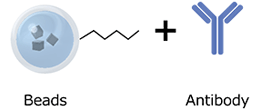
※Please scroll horizontally.
| Immobilization to NH2 group of protein | Immobilization with affinity binding | Immobilized with Avidin-biotin binding | Immobilization to SH group and NH2 group of protein | Immobilization to His-tag of protein | Immobilization with click chemistry | |
|---|---|---|---|---|---|---|
| It is possible to firmly immobilize the proteins by covalent bond to the beads. Since the NH2 groups on the protein is randomly immobilized on the beads, the orientation of the antibodies becomes disjointed. NHS beads are recommended because they are easier to operate than COOH beads. | Only antibodies can be immobilized on beads. The Fc site of the antibody binds to the beads by affinity. The immobilization operation is easy. | Immobilizes to beads with strong affinity binding. Immobilization requires biotinlation of the ligand. | Ligand immobilization is possible with inexpensive beads. However, temperature tolerance of the protein at 37℃ is required. | It is necessary to introduce His-tag into the protein. The beads also bind to the NH2 groups on the protein. | It is necessary to introduce His-tag into the protein. The beads also bind to the NH2 groups on the protein. | |
| (1)Antibody | ◎ | ◎ | ◎ | ○ | ○ | △ |
| Recommended beads | COOH beadsNHS beads | Protein A beadsProtein G beads | Streptavidin beadsNeutrAvidin beads | Epoxy beads | Ts beads | Azide beadsAlkyne beads |
◎:Recommended for use 〇:Available △:Can be used depending on the conditions ×:Not available
The antigens are immobilized on the beads by affinity or covalent bond.
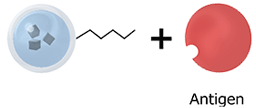
※Please scroll horizontally.
| Immobilization to NH2 group of protein | Immobilization with affinity binding | Immobilized with Avidin-biotin binding | Immobilization to SH group and NH2 group of protein | Immobilization to His-tag of protein | Immobilization with click chemistry | |
|---|---|---|---|---|---|---|
| It is possible to firmly immobilize the proteins by covalent bond to the beads. Since the NH2 groups on the protein is randomly immobilized on the beads, the orientation of the antibodies becomes disjointed. NHS beads are recommended because they are easier to operate than COOH beads. | Only antibodies can be immobilized on beads. The Fc site of the antibody binds to the beads by affinity. The immobilization operation is easy. | Immobilizes to beads with strong affinity binding. Immobilization requires biotinlation of the ligand. | Ligand immobilization is possible with inexpensive beads. However, temperature tolerance of the protein at 37℃ is required. | It is necessary to introduce His-tag into the protein. The beads also bind to the NH2 groups on the protein. | It is necessary to introduce His-tag into the protein. The beads also bind to the NH2 groups on the protein. | |
| (2)Antigen | ◎ | × | ◎ | ○ | ○ | △ |
| Recommended beads | COOH beadsNHS beads | Protein A beadsProtein G beads | Streptavidin beadsNeutrAvidin beads | Epoxy beads | Ts beads | Azide beadsAlkyne beads |
◎:Recommended for use 〇:Available △:Can be used depending on the conditions ×:Not available
After immobilizing the antibodies (or antigens) on the beads, the target antigens (or antibodies) are recovered (bound).

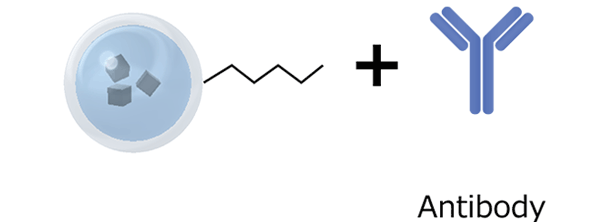
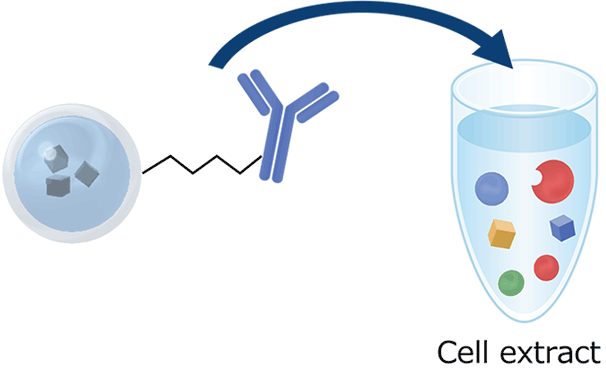
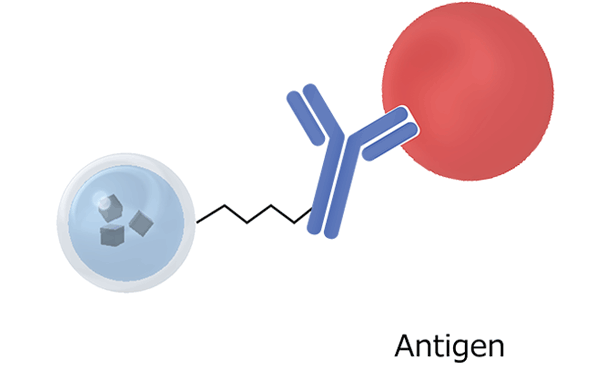
※Please scroll horizontally.
| Immobilization to NH2 group of protein | Immobilization with affinity binding | Immobilized with Avidin-biotin binding | Immobilization to SH group and NH2 group of protein | Immobilization to His-tag of protein | Immobilization with click chemistry | |
|---|---|---|---|---|---|---|
| It is possible to firmly immobilize the proteins by covalent bond to the beads. Since the NH2 groups on the protein is randomly immobilized on the beads, the orientation of the antibodies becomes disjointed. NHS beads are recommended because they are easier to operate than COOH beads. | Only antibodies can be immobilized on beads. The Fc site of the antibody binds to the beads by affinity. The immobilization operation is easy. | Immobilizes to beads with strong affinity binding. Immobilization requires biotinlation of the ligand. | Ligand immobilization is possible with inexpensive beads. However, temperature tolerance of the protein at 37℃ is required. | It is necessary to introduce His-tag into the protein. The beads also bind to the NH2 groups on the protein. | It is necessary to introduce His-tag into the protein. The beads also bind to the NH2 groups on the protein. | |
| (3)Direct method | ◎ | ◎ | ◎ | ○ | ○ | △ |
| Recommended beads | COOH beadsNHS beads | Protein A beadsProtein G beads | Streptavidin beadsNeutrAvidin beads | Epoxy beads | Ts beads | Azide beadsAlkyne beads |
◎:Recommended for use 〇:Available △:Can be used depending on the conditions ×:Not available
After performing the antigen-antibody reaction, the antigen-antibody complex is recovered with beads.

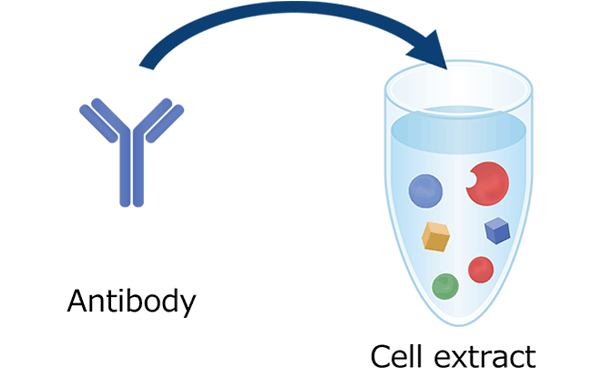
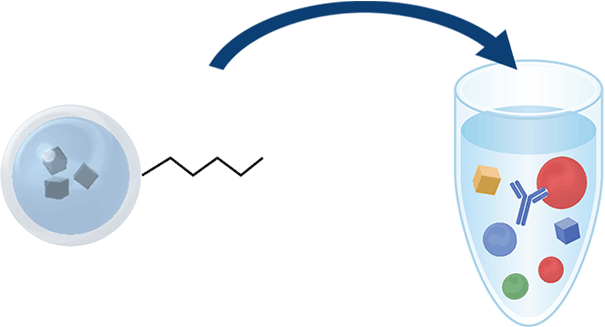
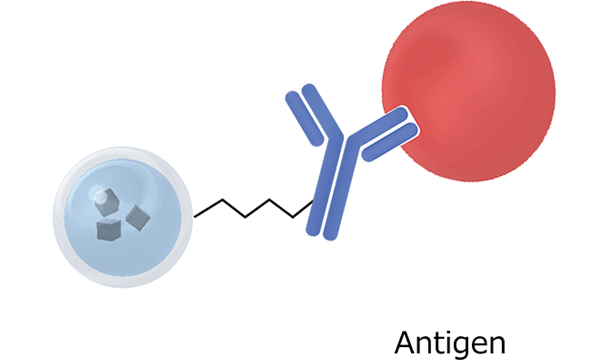
※Please scroll horizontally.
| Immobilization to NH2 group of protein | Immobilization with affinity binding | Immobilized with Avidin-biotin binding | Immobilization to SH group and NH2 group of protein | Immobilization to His-tag of protein | Immobilization with click chemistry | |
|---|---|---|---|---|---|---|
| It is possible to firmly immobilize the proteins by covalent bond to the beads. Since the NH2 groups on the protein is randomly immobilized on the beads, the orientation of the antibodies becomes disjointed. NHS beads are recommended because they are easier to operate than COOH beads. | Only antibodies can be immobilized on beads. The Fc site of the antibody binds to the beads by affinity. The immobilization operation is easy. | Immobilizes to beads with strong affinity binding. Immobilization requires biotinlation of the ligand. | Ligand immobilization is possible with inexpensive beads. However, temperature tolerance of the protein at 37℃ is required. | It is necessary to introduce His-tag into the protein. The beads also bind to the NH2 groups on the protein. | It is necessary to introduce His-tag into the protein. The beads also bind to the NH2 groups on the protein. | |
| (4)Indirect method | × | △ | ◎ | × | ○ | △ |
| Recommended beads | COOH beadsNHS beads | Protein A beadsProtein G beads | Streptavidin beadsNeutrAvidin beads | Epoxy beads | Ts beads | Azide beadsAlkyne beads |
◎:Recommended for use 〇:Available △:Can be used depending on the conditions ×:Not available
※Please scroll horizontally.
| Immobilization to NH2 group of protein | Immobilization with affinity binding | Immobilized with Avidin-biotin binding | Immobilization to SH group and NH2 group of protein | Immobilization to His-tag of protein | Immobilization with click chemistry | |
|---|---|---|---|---|---|---|
| It is possible to firmly immobilize the proteins by covalent bond to the beads. Since the NH2 groups on the protein is randomly immobilized on the beads, the orientation of the antibodies becomes disjointed. NHS beads are recommended because they are easier to operate than COOH beads. | Only antibodies can be immobilized on beads. The Fc site of the antibody binds to the beads by affinity. The immobilization operation is easy. | Immobilizes to beads with strong affinity binding. Immobilization requires biotinlation of the ligand. | Ligand immobilization is possible with inexpensive beads. However, temperature tolerance of the protein at 37℃ is required. | It is necessary to introduce His-tag into the protein. The beads also bind to the NH2 groups on the protein. | It is necessary to introduce His-tag into the protein. The beads also bind to the NH2 groups on the protein. | |
| (1)Antibody | ◎ | ◎ | ◎ | ○ | ○ | △ |
| (2)Antigen | ◎ | × | ◎ | ○ | ○ | △ |
| (3)Direct method | ◎ | ◎ | ◎ | ○ | ○ | △ |
| (4)Indirect method | × | △ | ◎ | × | ○ | △ |
| Recommended beads | COOH beadsNHS beads | Protein A beadsProtein G beads | Streptavidin beadsNeutrAvidin beads | Epoxy beads | Ts beads | Azide beadsAlkyne beads |
◎:Recommended for use 〇:Available △:Can be used depending on the conditions ×:Not available
Immunoprecipitation(1)
Learn More→
Immunoprecipitation(2)
Learn More→
Immunoprecipitation (3)
Learn More→
Immunoprecipitation (4)
Learn More→
Chromatin immunoprecipitation 1
unichi Yamamoto, Tokyo Medical University
Learn More→
Chromatin immunoprecipitation 2
obuo Horikoshi, Houston Methodist Research Institute Weill Cornell Medical College
Learn More→
Enhancing Mass spectrometry-based tumor immunopeptide identification: machine learning filter leveraging HLA binding affinity, aliphatic index and retention time deviation
Computational and Structural Biotechnology Journal 23 (2024) 859–869
Caspase cleaves Drosophila BubR1 to modulate spindle assembly checkpoint function and lifespan of the organism
The FEBS Journal 290 (2023) 4200–4223
Proteolytic ectodomain shedding of muscle-specific tyrosine kinase in myasthenia gravis
Experimental Neurology 361 (2023) 114300
PROX1 induction by autolysosomal activity stabilizes persister-like state of colon cancer via feedback repression of the NOX1-mTORC1 pathway
Cell Reports 42, 112519 June 27, 2023
Integrative analysis reveals early epigenetic alterations in high-grade serous ovarian carcinomas
Experimental & Molecular Medicine (2023) 55:2205–2219
The N‑terminal disordered region of ChsB regulates its efcient
Current Genetics (2023) 69:175–188
Immuno-Mass Spectrometry Workflow for Quantification of Serum α-Fetoprotein Using Antibody-Immobilized Magnetic Beads and Modified Eluents.
Mass Spectrom (Tokyo). 2023;12(1):A0122.
Tumor Suppressive Role of the PRELP Gene in Ovarian Clear Cell Carcinoma
J. Pers. Med. 2022, 12(12), 1999; https://doi.org/10.3390/jpm12121999
Targeting necroptosis in muscle fibers ameliorates inflammatory myopathies
Nature Communications volume 13, Article number: 166 (2022)
An oncogenic splice variant of PDGFRα in adult glioblastoma as a therapeutic target for selective CDK4/6 inhibitors
Scientifc Reports (2022) 12:1275
α1,4- Linked N- acetylglucosamine suppresses gastric cancer development by inhibiting Mucin-1-mediated signaling.
Cancer Science. 2022;00:1–12
Downregulation of METTL6 mitigates cell progression, migration, invasion and adhesion in hepatocellular carcinoma by inhibiting cell adhesion molecules
INTERNATIONAL JOURNAL OF ONCOLOGY 60: 4, 2022
Chondroprotective effects of CDK4/6 inhibition via enhanced ubiquitin-dependent degradation of JUN in synovial fibroblasts
Rheumatology 2022;61:3427–3438
ILF2 enhances the DNA cytosine deaminase activity of tumor mutator APOBEC3B in multiple myeloma cells
Scientific Reports volume 12, Article number: 2278 (2022)
Identification of the mutation signature of the cancer genome caused by irradiation
Radiotherapy and Oncology 155 (2021) 10
A PX-BAR protein Mvp1/SNX8 and a dynamin-like GTPase Vps1 drive endosomal recycling
eLife 2021;10:e69883.
Exploiting ubiquitin ligase cereblon as a target for small-molecule compounds in medicine and chemical biology
Cell Chemical Biology 28, July 15, 2021
Comprehensive analysis on the whole Rho-GAP family reveals that ARHGAP4 suppresses EMT in epithelial cells under negative regulation by Septin9
The FASEB Journal. 2020;34:8326-8340
N-glycosylation of Rim21 at an unconventional site fine-tunes its behavior in the plasma membrane
Cell Structure and Function 2020, https://doi.org/10.1247/csf.19021
Development of an automatic magnetic immunostaining system for rapid intraoperative diagnosis of cancer metastasis
AIP Advances 10, 015106 (2020)
Artificial switching of the metabolic processing pathway of an etiologic factor, β2-microglobulin, by a “navigator” molecule
Journal of Controlled Release 327 (2020) 8–18
TORC1 inactivation stimulates autophagy of nucleoporin and nuclear pore complexes
Journal of Cell Biology 2020 Vol. 219 No. 7 e201910063
Pex3 confines pexophagy receptor activity of Atg36 to peroxisomes by regulating Hrr25-mediated phosphorylation and proteasomal degradation
J. Biol. Chem. (2020) 295(48) 16292–16298
Wash-free detection of biological target using cluster formation of magnetic markers
Journal of Magnetism and Magnetic Materials 500 (2020) 166356
Super-assembly of ER-phagy receptor Atg40 induces local ER remodeling at contacts with forming autophagosomal membranes
NATURE COMMUNICATIONS (2020) 11:3306
Hdac4 Interactions in Huntington’s Disease Viewed Through the Prism of Multiomics
Molecular & Cellular Proteomics 18, S92–S113 (2019)
A bipartite sorting signal ensures specificity of retromer complex in membrane protein recycling
J. Cell Biol. 2019 Vol. 218 No. 9 2876–2886
Mismatch repair dependence of replication stress-associated DSB recognition and repair
Heliyon 5 (2019) e03057
Y. Kabe et al. (2019) [ExoCounter]
Application of high-performance magnetic nanobeads to biological sensing devices.
Aal. Bioanal. Chem., doi: 10.1007/s00216-018-1548-y (2019).
Magnetically Promoted Rapid Immunofluorescence Staining for Frozen Tissue Sections
J. Histochem. Cytochem., Epub 2019 Apr 8
Stable Accumulation of Photosystem II Requires ONE-HELIX PROTEIN1 (OHP1) of the Light Harvesting-Like Family
Plant Physiology, Volume 176, Issue 3, March 2018, Pages 2277–2291
ISGF3 with reduced phosphorylation is associated with constitutive expression of interferon-induced genes in aging cells
npj Aging and Mechanisms of Disease (2018)4:11
A Novel Autoantibody against Plexin D1 in Patients with Neuropathic Pain
Ann. Neurol., 84, 200 (2018).
Wash-free detection of C-reactive protein based on third-harmonic signal measurement of magnetic markers.
Jpn. J. Appl. Phys., 57, 112, 090309 (2018).
The Atg2-Atg18 complex tethers pre-autophagosomal membranes to the endoplasmic reticulum for autophagosome formation
Proc. Natl. Acad. Sci. USA, 115, 10363(2018)
Transport Granules Bound with Nuclear Cap Binding Protein and Exon Junction Complex Are Associated with Microtubules and Spatially Separated from eIF4E Granules and P Bodies in Human Neuronal Processes
Front. Mol. Biosci. 4:93. doi: 10.3389/fmolb.2017.00093
Accumulation of undegraded autophagosomes by expression of dominant-negative STX17 (syntaxin 17) mutants
Autophagy, 13:8 (2017), 1452-1464
Autophagosome formation is initiated at phosphatidylinositol synthase-enriched ER subdomains
The EMBO Journal (2017)36:1719-1735
A new efficient method of generating photoaffinity beads for drug target identification
Bioorg. Med. Chem. Lett., 27, 834 (2017).
A proteomics method using immunoaffinity fluorogenic derivatization-liquid chromatography/tandem mass spectrometry (FD‐LC‐MS/MS) to identify a set of interacting proteins.
Biomedical Chromatography, DOI: 10.1002/bmc.4063 (2017).
Xeroderma pigmentosum group C protein interacts with histones: regulation by acetylated states of histone H3
Genes to Cells (2017) 22, 310–327
TLR7 mediated viral recognition results in focal type I interferon secretion by dendritic cells
NATURE COMMUNICATIONS 8: 1592
Generation of Immunity against Pathogens via Single-Domain Antibody–Antigen Constructs
J Immunol December 15, 2016, 197 (12) 4838-4847
